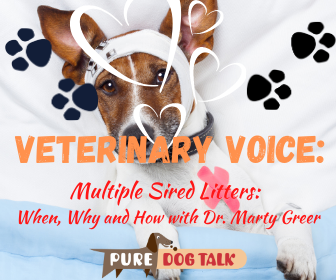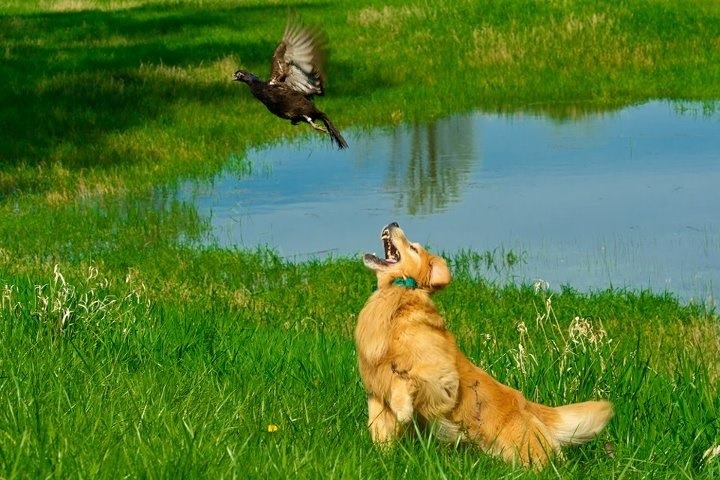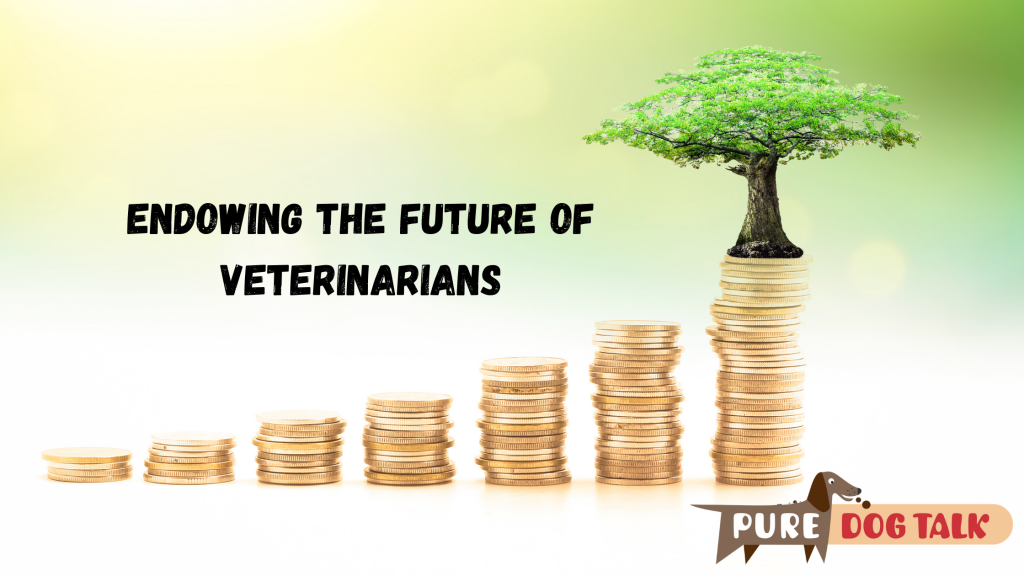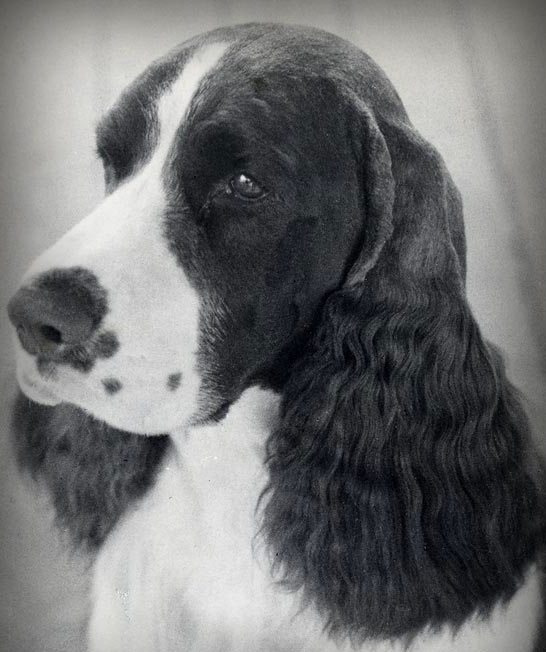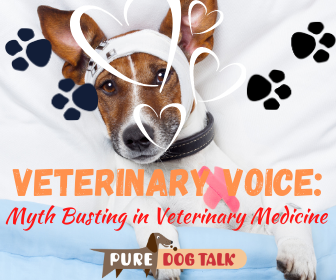475 – Multiple Sired Litters: When, Why and How with Dr. Marty Greer
Multiple Sired Litters: When, Why and How with Dr. Marty Greer
Dr. Marty Greer and host Laura Reeves review the when, why and how of multiple-sired litters. AKC instituted the policy for multiple-sired litters in 2000 with the advent of reliable parentage DNA testing.
Planning for a multiple-sired litter requires taking a variety of factors into consideration.
- The quality and condition of the semen. Greer notes that poor-quality semen should get a “head start” and be inseminated first. Frozen, fresh chilled and live semen all have different rates of motility and viability as they journey toward the eggs.
- The age and reproductive viability of the bitch. Greer advocates for a first litter. “I like a pink, shiny, healthy new uterus,” Greer said. “But it’s got the risk of not knowing what her fertility is and it’s got the risk of not knowing what kind of maternal skills she has.”
- Cost is a factor, as sire, dam and all puppies require DNA parentage testing through AKC in order to be properly registered.
- The “relatedness” of the sires being considered. While DNA testing can differentiate related sires, a father and son or similar closely related dogs can be more challenging to nail down. “We had a Border Terrier… usually they go out, I think, 13 genes and they had to go out 23 because the dogs were so closely related,” Greer said.
- The knowledge and experience of your veterinarian. “(Work) with somebody that does a lot of canine reproduction. This is not for your ordinary, garden variety veterinarian. Those are good people, don’t get me wrong, but when you’re doing something of this level of sophistication, you need to have somebody that doesn’t misunderstand what you want to do and doesn’t think that fresh chilled semen goes in the freezer and knows how to put it in so that it gets into the uterus.”
- Freeze potential sires while they are young and healthy. “If you have a young up and coming stud dog, freeze early and freeze often. Even if it’s not up and coming, even if it just might be up and coming … if he’s good enough for you to keep, freeze him. You can always do the health screenings later.”
- Consider creating a “sperm bank” for your national breed club. Working with AKC, Greer said the prototype created by the Otterhound Club of America is now available to all clubs. “We’ve got a tool kit put together. Our next step is to start educating breed clubs. So if you’re listening and you have a breed club and you’re on the genetics committee or you’re a member or you have a dog that you would like to have semen retained on this is really really, really super important. We’re going to need to breed our way out of some of these corners and without that genetic material stored, it’s not going to happen. So, you now have the opportunity to work with your breed club, your veterinarian, the AKC, the society for theriogenology… there’s a whole bunch of people that are involved in this because everybody sees the big picture value of this.”
474 – Dreaming of Dual Dogs: Rush Hill Golden Retrievers
473 — Endowing the Future of Veterinarians
472 — Linda Riedel: International Dog Shows and 50 Years of Dogs
Linda Riedel: International Dog Shows and the Secrets of 180 Champions
 Linda Riedel, AKC judge and breeder of Ramblewood English Springer Spaniels, joins host Laura Reeves for a free-wheeling conversation about IABCA dog shows and her journey to 180 champions.
Linda Riedel, AKC judge and breeder of Ramblewood English Springer Spaniels, joins host Laura Reeves for a free-wheeling conversation about IABCA dog shows and her journey to 180 champions.
A few excerpts follow below.
On International dog shows
I really like that it in this Covid time, (IABCA) shows have been great for people to get their dogs out, which they haven’t been able to do. We used to have all-breed matches that were huge. I can remember in California they’d get up to 2,000 dogs in a match. That’s where you’d train your dog. Well that doesn’t happen anymore, so these International shows are very good for the beginning person, for people who need to get their dogs trained and out and exposed to all kinds of people and other dogs. So, it works out well.
I mean there were people that were at matches all the time. It was like a professional match circuit. We don’t have those anymore and it’s a great loss. And that’s where I see something like this sort of filling in.
In terms of getting your dog in the ring, getting yourself in the ring, if you’re just learning how to show your dog, you have so many chances. You could be in the ring 6 or 8 times in one day.
(Exhibitors) find out we (judges) are humans, just like them, and can carry on a conversation. They get a lot more relaxed and enjoy their day and enjoy their dogs.
(Writing and receiving critiques of the dogs) helps people breed better dogs and educate better judging.
It’s a two way street, both for the exhibitor and the judge. You know too many exhibitors are too terrified with all the time (constraints) and everything else, they say to the judge ‘why did I not win today’ and the judge pops out and says ‘well I like the other dog better.’ That is not a reason.
411…
Reidel started in dogs working for the famous Akita Tani kennel winding up as a teenaged advisor to the stars helping train Akitas purchased by Hollywood’s glitterati.
On 50 years of breeding
- Never kept more than 8 dogs at a time.
- Nobody’s more critical of my dogs than I am. I’m not taken in by their cuteness.
- Line breed heavily to set type.
- Retirement homes — Time for them to find a couch they can sit for the rest of their lives.
- Breeder of the most titled dog in the history of the breed and the top performance dog of the year.
Hear ALL of this fabulous conversation by clicking the “play” arrow on the podcast bar above.
471 – Myth Busting in Veterinary Medicine
Myth Busting in Veterinary Medicine
Dr. Marty Greer, our veterinary voice, joins host Laura Reeves for a fun episode by multiple listener request. They tackle old wives tales and do a bit of myth busting on veterinary medicine.
Q: Do bitches in season cycle together?
Yes.
“I think it’s true. I really do believe that happens. There’s hormones, there’s pheromones. It’s called convent syndrome or dormitory syndrome in humans. Absolutely it happens in dogs too.
“There’s a reason for that… it was thought that bitches would cycle together so that there would be additional mothers available to lactate should puppies be orphaned or otherwise the bitch wasn’t available to nurse her puppies.
“They cycle together, they all come into heat at the same time, they start excreting or secreting a pheromone weeks before they come into heat so that they can start recruiting male dogs so that they are available at the time that the bitch is ready to breed.
Q: Do intact male dogs need drugs when bitches are in season?
Yes.
“There’s no reason not to put a male dog on some kind of an anti anxiety medication.”
Q: Matings can happen through chain link?
Yes
“The drive to have a sexual encounter is a very, very strong drive in every species. We all know that … we’ve got pictures of dogs that know how to unlatch their kennel door, walk across the top of a kennel, drop down into the female’s pen, breed the female and then walk back out and get back into their own kennel. We have proof that these dogs are doing this because we now have video in people’s kennels.
“It’s a fascinating study in canine behavior but yes the boys do have a pretty strong drive and the females are very cooperative at that point. Yes you can use drugs. Keeping them separated physically is useful. But there is nothing that you can do that they can’t undo faster because they’re spending 23 hours and 49 minutes a day trying to figure out a way to get that particular encounter to happen and you spent 11 minutes that day figuring out a way for it not to happen.
“Anybody that tells you that they’ve never had an accidental breeding, that owns both males and females that are intact at their house, is either lying to you or it hasn’t happened to them yet.
Q: Does chlorophyll when given immediately when the bitch comes in season reduce the odor?
No
“It’s gonna help to a small extent, but it’s not going to be enough to cover up everything. No charcoal, chlorophyll, vanilla, Vicks, you name it, all the things that people try (is) going to overcome every single molecule. Remember dogs have probably 10,000 times the number of scent cells an inside their nose (than people).
Q: Will females that have pyometra always have a fever?
No.
“The uterus is a privileged organ. It isolates proteins that aren’t part of that particular individual’s DNA. That allows the little puppies to develop and grow and be born as little puppies and the uterus doesn’t say ‘oh you don’t belong here and have some kind of immune response that kicks them out.'”
470 — Molosser Breeds Evoke Old World Characteristics
469 – Curating Living History Through Purebred Dogs
468 – Bloat 911: Know the Signs, Be Prepared
Bloat 911: Know the Signs, Be Prepared
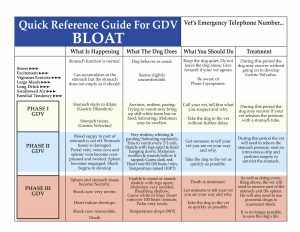
PRINT this chart for reference in your dogs’ area.
Dr. Marty Greer, DVM joins host Laura Reeves for a primer on one of the most terrifying and emergent situations we can encounter with our dogs – bloat. Most noted in large and giant breeds of middle to advanced age, Greer notes that small dogs and puppies are not immune.
“There are parts of this that no one still understands,” Greer said, “even though we’ve known about gastric dilatation volvulus, GDV or bloat, for decades and decades. I mean, when I was in veterinary school, it was a big deal. Unfortunately, we have still a lot of holes in the knowledge we have about it.
What happens
“Essentially what happens is the stomach fills with fluid, air, food, different materials and in gastric dilatation it dilates. In gastric dilatation volvulus it dilates and then rotates inside the abdomen.
“It can be one or both. The distinguishing feature is going to be available only by X Ray. Just looking at a dog at a dog show or in your hotel room or at your house and your kennel, in the veterinary lobby, you can’t tell the difference between a volvulus and a dilatation. So, an X Ray is needed to determine what’s going on.
Why it happens
“(When) material starts to fill the stomach and it starts to dilate, there’s some kind of an outflow obstruction, which is not clearly identified, which keeps the fluid and gas from being able to go down into the small intestine. The stomach dilates further and further and further …gas is produced either by fermentation or by gulping air.
“The dogs typically will attempt to vomit, but are unproductive in their efforts …That’s probably the one distinguishing thing that you can determine when you’re looking at a dog, as the abdomen is distended… if they’re able to productively vomit, food is coming up, fluid is coming up, it’s probably not a boat. If their efforts to vomit are unproductive, you have a genuine life crisis medical emergency on your hands and you cannot get to a veterinary clinic for care fast enough.
“The problem is this becomes this really vicious cycle of metabolic and respiratory and circulatory disasters that just feed on each other. As soon as the stomach starts to fill with gas, the dog develops acidosis. They can’t produce any vomit. The stomach starts to press on the diaphragm, so they can’t breathe adequately. And then their circulation starts to slow down because there’s pressure on the vena cava.
“There are all these metabolic cascades that start to happen that become a vicious cycle. One makes the next part worse, which makes the next worse, which makes the next worse. Which is why the dogs decompensate and die of shock or ruptured stomach or cardiac malfunctions.
What can you do?
“There are some correlations that people have made with the time of eating and the amount of exercise afterwards, but there’s not a strong correlation. You can follow every single guideline that you possibly have ever read about to try and reduce the risk of it. And it can still happen anyway. That’s what’s really devastating about it … You feel really helpless because you can’t prevent it and you can’t predict it. And when it happens, it doesn’t matter what time of the day it is. You need immediate medical care. Half an hour ago.
“(The stomach is noticeably distended)… it can sound like a watermelon when you thump it… so if there’s any possibility, a little inkling that something is not right, if a dog is restless, won’t lay down, won’t eat, won’t drink, and it’s really non-productively trying to vomit, you go get an X Ray. Period, end of discussion.
“You call the emergency clinic on your way. You tell them what you have for a breed, the circumstances and you say I’m coming in for an X Ray. And you hope to God that there’s not six other really serious medical emergencies ahead of yours so that you can get the immediate attention that’s required.
“If you have the option of going to two different practices, you’ll probably want to call ahead and see who can accommodate you when you arrive, because there is no sitting in the parking lot and waiting. There is no calling in the surgeon. There is no ‘we’ll get around to you when we get around to you.’ It is right now.”
Listen to the rest of our conversation to learn about passing a stomach tube to give the dog more time, prophylactically tacking the stomach, potential genetic predisposition that can impact breeding decisions and more.
Listen HERE for our previous podcast on first aid for bloat and other emergencies.
467 – Proposed CA Legislation Radically Regulates All Dog Breeding
466 – Borzoi: Epitome of Elegant yet Powerful Hound
Borzoi: Epitome of Elegant yet Powerful
Borzoi breeders Kristina Terra and Corrine Miller join host Laura Reeves to learn more about the powerful, elegant sighthounds made popular by Russian nobility.
Once known as the Russian Wolfhound, the Borzoi’s history provides a fascinating study of the Russian aristocracy.
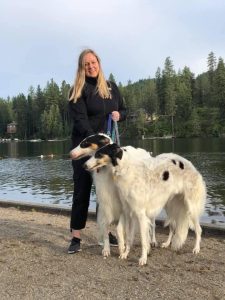 “I think the Russian Wolfhound, it’s a bit of a misnomer,” Terra, president of the International Borzoi Council, said. “Because, actually, the breed in its native land used to hunt many things other than Wolves, but Wolves also. So they were initially bred as a typical sight hound that would hunt the European hare, kind of like a jackrabbit. They’re big in the Russian steppes and the big open spaces but also the forest meadows. So those sighthounds initially had to have a lot of speed on short distances.”
“I think the Russian Wolfhound, it’s a bit of a misnomer,” Terra, president of the International Borzoi Council, said. “Because, actually, the breed in its native land used to hunt many things other than Wolves, but Wolves also. So they were initially bred as a typical sight hound that would hunt the European hare, kind of like a jackrabbit. They’re big in the Russian steppes and the big open spaces but also the forest meadows. So those sighthounds initially had to have a lot of speed on short distances.”
Terra, along with her mother, moved from St. Petersburg, Russia to the United States and acquired their first Borzoi in 1993.
“The first depiction of a Russian wolfhound, Borzoi, is actually at the Saint Sophia cathedral in Kiev, Ukraine,” Terra noted. “It’s one of the frescoes. Since Sophia cathedral dates back to 1037, that is one of the first depictions (of the breed) And also in the illuminated Chronicles of a couple of centuries later, there’s another beautiful depiction of one of the czars hunting with Borzoi. So that’s kind of the second depiction of the breed.
“So the breed goes back ancient and it has changed over the years. Different breeds have been added to it. As the country changed both geographically, you know the forests were cleared, so more stamina was required of a sighthound, the breed changed. Also as the country changed politically, for instance when the serfdom was abolished, when the big aristocratic families of Russia could no longer take care of big kennels, then the breed changed again. But it has always been the symbol of that country and just the epitome of an elegant, yet powerful creature.
“The Royal family is always the one that draws the most attention and just kind of nostalgia, and these beautiful tales and palaces. Of course the Russian czars, they had their own hunt it was the Imperial hunt and it was in the suburb of Saint Petersburg. But one of the biggest breeders and the most famous kennels of the time was actually the czar’s uncle.
“But that was just the czar’s family. There were many Noble families across this vast country and they all considered it their duty to have their own line of beautiful Borzoi and they all competed against each other in how beautiful their Borzoi were, and how fast and agile they were, and how many Foxes or hare or Wolf they could catch.
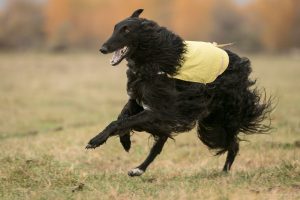 “They would have many kind of field trials, where different neighboring land owners would get together with their dogs and just compare them. The very first written description of the breed appeared in an article in a hunting magazine in 1888. That description was voted on by the Imperial hunting society members. They all voted on that and I suppose that could be called the first standard of the breed.”
“They would have many kind of field trials, where different neighboring land owners would get together with their dogs and just compare them. The very first written description of the breed appeared in an article in a hunting magazine in 1888. That description was voted on by the Imperial hunting society members. They all voted on that and I suppose that could be called the first standard of the breed.”
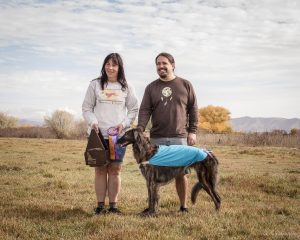 Miller added, “a lot of them (breeders) wrote their own standards, which was interesting. There was one (that was) like ‘oh the black and tan ones are the best’ and then this other guy that lived over the other ways like ‘Oh no, tan markings is bad.”
Miller added, “a lot of them (breeders) wrote their own standards, which was interesting. There was one (that was) like ‘oh the black and tan ones are the best’ and then this other guy that lived over the other ways like ‘Oh no, tan markings is bad.”

